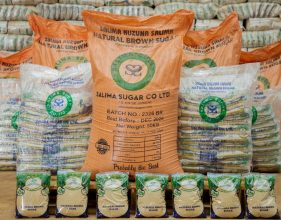Limited access to markets stifling Irish potato production
Irish potato farming in Malawi is helping smallholder farmers feed their families and boost their incomes by supplying to local markets. But despite increased volumes in the production of the commodity, Malawi’s Irish potato farmers are faced with yield wastage and low prices, especially during plentiful harvest seasons due to lack of proper market structures.
In a mapping exercise for Irish potato production and marketing by Civil Society Agriculture Network (Cisanet) with financial support from RLEEP early February in Ntchisi, Dedza and Mchinji, marketing systems for inputs and outputs were singled out as critical issues disadvantaging farmers.
 Evaristo Njoka, a member of Kanyama Producers and Marketing Cooperative Society in Dedza, observed that the lack of suitable marketing infrastructure and efficient marketing systems both for inputs and outputs places farmers at a disadvantage.
Evaristo Njoka, a member of Kanyama Producers and Marketing Cooperative Society in Dedza, observed that the lack of suitable marketing infrastructure and efficient marketing systems both for inputs and outputs places farmers at a disadvantage.
“Farmers in remote areas have seen demand for their produce fall, resulting in low prices dictated by the few vendors who travel to these areas.
“They know that eventually, farmers will be obliged to sell their produce at virtually whatever price is offered,” said Njoka.
Similar sentiments were shared by Katamanda Tembo of Upper Mpherere in Ntchisi. He stated that smallholder farmers, who are usually poor and rural-based, live in remote areas with few roads and means of transport, which limits their economic opportunities.
“In view of the prevailing market imperfections, including poor infrastructure (lack of good roads and established markets) and limited incomes, the scope for meeting the food security needs of marginal farmers from market supplies is limited,” he said.
It was observed during a visit to Kanyama Producers and Marketing Cooperative Society in Dedza that roads are in poor condition.
“This condition worsens in the rainy season, making it difficult to transport agricultural commodities, including Irish potatoes, most of which are highly perishable, to their final markets,” said Velemu Chizula, chairperson of the cooperative.
He noted that the poor state of feeder and access roads was one of the most serious constraints to agricultural development in the districts.
“The situation is particularly lamentable for feeder roads, but also in some cases access roads linking villages. This results in the increased cost of farm inputs and agricultural equipment while at the same time lowering prices of farm outputs.
“The latter is a consequence of the fact that it is very costly to transport farm outputs from the centres of production in the villages,” he said.
On the other hand, farmers also complained that there is lack of market information regarding Irish potato production and marketing.
Agnes Kwakwala, a member of Upper Mpherere Irish Potato Cooperative urged government to vigorously publicise market information on prevailing prices for various products, including Irish potato.
“This will enable farmers to better negotiate with traders coming to buy their farm outputs. Information on available supplies should also be made available to traders in the nearest towns, thereby enabling farmers and traders to make informed decisions as to when, where and at what price to sell and buy farm produce.
“This would encourage more traders and producers to come forth, enlarging the markets for available produce and increasing competition for products, which would boost prices,” she said.
Kwakwala stressed that due to the poor access to markets and market information in most parts of the country, there are huge post-harvest losses in the Irish potato industry, especially during peak production periods between March and October.
Farmers claimed that situations such as these have regularly been reported, but there has been little attention from government, leading to unsatisfied demand elsewhere within the country.
Apart from the difficulties resulting from shortcomings of the physical infrastructure, there is a general trend of rising prices of most farm inputs, farmers said.
Farmers in the mapped districts have also lamented lack of access to and cost of farm inputs. In the areas covered in the mapping exercise, the use of improved seeds, fertilisers, herbicides and pesticides is constrained by limited availability and high cost.
In the villages visited during the field work, round trip distances to the nearest inputs suppliers ranged between 30 and 40 kilometres.
These are considered prohibitive distances, especially with the poor state of rural feeder roads and lack of reliable means of transport.
The farmers have, however, suggested that government should facilitate linkage to credit institutions to ease problems of accessing farm inputs.
Farmers also want government to invest in irrigation and rainwater harvesting to boost the Irish potato farming.
Irrigation is also one important but expensive way of enhancing the productivity of land. To make the investment worthwhile, irrigation infrastructure must be regularly maintained and used with maximum efficiency.
Farmers reported that irrigation efficiency is deteriorating as a result of water being lost through seepage along the walls and floors of the canals.
“We need a lot of cement to plaster the canal walls and floors followed by regular and careful maintenance to ensure smooth water flow,” said Christina Chifuka of Chiphanga Cooperative in Ntchisi.
Apart from rivers and streams as sources for irrigation, rain water harvesting and conservation for irrigation and drinking by humans and livestock is another way of improving productivity.
It is, therefore, important for policymakers to note the farmers’ concerns for Irish potato farming to remain relevant to alleviate poverty, beat the scourge of hunger and malnutrition.
Researchers have observed that despite the availability of better technologies, productivity of most crops, including Irish potato has not improved over the years, largely as a result of declining soil fertility.
Also contributing to the low yields are poor access to financial services and markets, unfavourable weather, small landholdings and nutrient-depleted soils, coupled with limited use of fertilisers.
The use of improved varieties, together with fertilisers, better crop husbandry and irrigation, has the potential to greatly improve yields.





